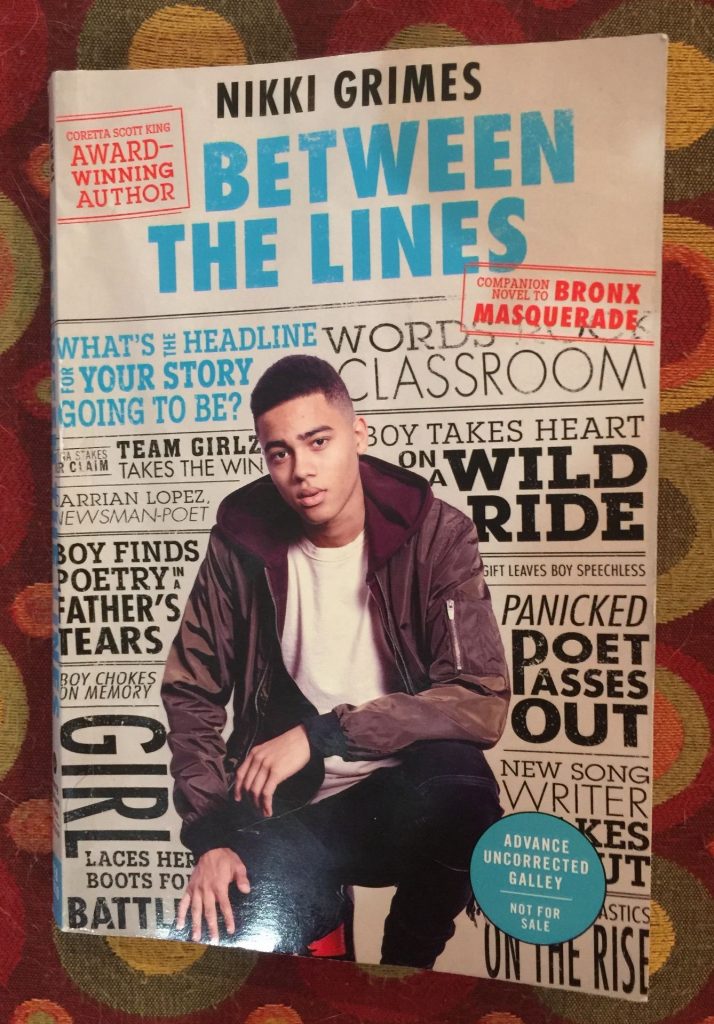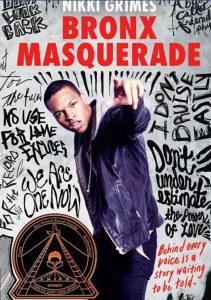There are times when the announcement of a book brings out the mendicant within me. Friends in the profession tell me no one can sponge like I can when in the exhibition hall or at the booth. My response is that I sponge after my own heart. A heart for books and story and a heart for the reader with whom I might share a highly-anticipated book. Such is the case for Laura Ingalls Wilder Award Winner Nikki Grimes and the upcoming release of Between the Lines (Nancy Paulsen Books February 2018). To catch a first glimpse of Between the Lines much like the moment of realization that the trailer for the film you are watching is a return to a beloved story you have loved before.
And that Nancy Paulsen’s expert and tender touch is upon this book is like seeing Spielberg or Lucas’s name come up in that trailer.
For those who have shared the 2003 Coretta Scott King Award winner, Bronx Masquerade, to see that original publishing date means something right away.
We are all sixteen years older since we first met Mr. Ward and his Poetry Friday students.
Sixteen years.
I first encountered Bronx Masquerade in a pre-service classroom led by Dr. Kevin Sue Bailey at Indiana University Southeast. This smaller trim sized book is etched in my mind with its narrator, Tyrone Bittings in the yellow windbreaker in front of a brick wall looking upward has the familiarity and the recognition that is seen only in picture books like The Snowy Day where the mere mention calls to the mind Peter in his red coat. Bronx Masquerade is one of the books that made me fall in love with middle grade and young adult literature early on. It’s like Nikki Grimes’s exploration of poetry and its impact upon the student and the room met me at the door of my own practice and it has been at my fingertips ever since.
As I often say in Room 407, the only person getting older in the room is me. This week, while reading the new book, I began to think about Between the Lines not as a completion of Bronx Masquerade but as a companion piece. And this consideration may be both selfish need and a social necessity all at the same time. In sixteen years, the physical, mental, social, and spiritual needs of our young people have not changed that much at all. And therefore, Between the Lines works so nicely as a companion text. This is not the shark jump of Beverly Hills 90120. This is not Saved by the Bell: The College Years.
This is Nikki Grimes bringing us back to the room where it started for so many readers. Mr. Ward, like all of us has grown a year older. Poetry Friday students from the first year have moved on. A new group of students enter. Grimes does a wonderful job of bringing each student onto the stage and into the story in prose and personal poetry that make the seven new poets easy to meet and to track through the story arc. And their names are on the tip of my tongue after my first read through of the new book.
The book opens with the narrative introduction to our narrator, Darrian Lopez, a Puerto Rican student living with his father who drives the city bus and holds a quiet hope for his son. Darrian is interested in journalism and writing for the New York Times. His interest is in getting the story right, especially when that story concerns young black and brown subjects like himself. An inquiry into how to break into newspaper writing is met with a suggestion to study articles, essays, short stories. .and poetry.
And, from here, Darrian enrolls in and enters Mr. Ward’s classroom.
In the book, readers meet Li. And Jenisis. And Marcel. And Valentina. And Kyle. And Angela.
And we are reunited with the young man who will serve as mentor to this new group of poets:
Tyrone Bittings.
Grimes’s style brings the poets and the reader into the poetry through Mr. Ward and his gentle invitation to try different entries into poetry to include starting with a story, freewriting, and sharing out from early drafts of pieces in the room.
Like its predecessor, Between the Lines presents through poetry the psycho-social and social-economical concerns of each poet. And this is where the sixteen-year gap between the two books closes quickly. Between the Lines brings the reader to cultural identity, to the uncertainty of home, to fragility of health, to alcohol abuse and parenting by proxy, to a moment that could change the course of a young life, to anxiousness that is ubiquitous while personal in the classroom setting.
Grimes reminds us by embodying once again these seven young poets that poetry invites reflection, invites restoration, and foster reclamation. And, she reminds us that none of these occur in a bubble. Reflection is stolen away from the chaos of the quotidian. Restoration is often found in the hands of the court of law and the court of the culture. And reclamation often involves the movement of self and those around the self that make what was broken whole again.
As she has done in the earlier book, master poet Grimes is able to slip into the role of each poet to draw out the inner voice wrapped in the outer narrative. The inner narrative rendered in verse is a gift to the reader who gets to forget that this is one author writing in the voice of seven characters.
Darrian Lopez as narrator of the book works as nicely. He is a little more reserved than the rich-with-bravado, Billings. While his voice still has all the stuff of an adolescent young man, it is his initial attempt at poetry and his willingness to seek out and to accept critical feedback that makes him immediately endearing to this reader. Further, his interest in and his receptiveness to the other students that seals the deal in making him a likable narrator. A feature of the new book is Darrian’s offering a headline summary of what has just happened in the book that serves as a mentor text for creative titling that classroom teachers are going to love.
Like Bronx Masquerade, Nikki’s new book is full of the allusions that provide what Teri Lesesne has coined, “reading ladders.” Allusions to e. e cummings, the Harlem Renaissance, Jean Toomer, and Marcel Marceau (which already has me reaching for the 2012 Leda Schubert picture book, Monsieur Marceau). Li Cheng’s character introduces us to contemporary Chinese poets, William Marr, Ah Xin, Chen Yanqiang, and Li Li adding to the richness of diversity offered by the book. And, like Bronx Masquerade, the student-delivered pieces can serve as mentor texts for young writers who might want to try to follow the template to explore narrative subjects of their own.
Finishing the book this week, I have a small dream for Nikki Grimes’s new work. In my dream share, Bronx Masquerade would be shared in an earlier grade like 9th or 10th grade (don’t be swayed by reading levels that put this book at a lower grade range—the exploration of some social concerns really invites and require an older audience than leveling invites) with the students moving into the next grade with the new class presented in Between the Lines.
Nikki Grimes’s invites us to be in the lives of the characters she has created. And their authenticity is probably found in the life that Grimes has lived as person and as poet. The author’s note at the end of the book leaves the reader with a sense of “know and do something” that helps to bring out the concerns and the very livelihood of one of the characters within the book who presents with a certain sense of toughness that can be read as abrasive. That Nikki Grimes offers some back material into the statistics around that character made this reader go back and read those pieces and poems again with new eyes. Isn’t this what we want for student readers too?
You have a bit of a wait for this new book. It has a February release. I would consider this a literary valentine. After all, what is poetry if not heart? And home.

